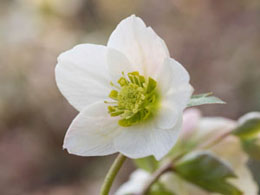Lenten rose is a member of the genus, 'Helleborus'. The plant can bloom as early as late winter, and thus announce the arrival of spring after the long reign of winter. Find out more interesting facts about this plant, in this Buzzle article.

Lenten rose is a perennial plant of the genus
Helleborus, which includes almost 20 species of herbaceous or evergreen perennial flowering plants. Though commonly known as lenten rose, this plant is not related to the rose family,
Rosaceae. Instead, plants of the genus
Helleborus, belong to the family,
Ranunculaceae.
Lenten rose or
Helleborus orientalis is known to be an early bloomer. Its attractive blossoms usually appear in the late winter or early spring; the reason for which it is cherished by the gardeners. This plant is surprisingly resistant to frost, and is an evergreen plant in the warmer regions. It got the name, 'lenten rose', as its blooming time coincides with the time of Easter celebration of Lent.
Plant Description
It is a small herbaceous plant that can reach up to a height of 18 to 24 inch. Apart from the flowers, another interesting feature of the plant is its dark green, leathery foliage. The leaves are evergreen in warmer climates, and they are quite large with a length of about 46 cm and a width of 41 cm.
The much cherished flowers of this plant actually consist of colorful sepals, not petals. So, an individual flower consists of five sepals that look like petals, while the actual petals modify to form a ring of small, cup-like nectaries to hold the nectar. The flowers can come in an array of colors, from white, pink, greenish to purple. They are held above the foliage in loose clusters, with the flower heads bending towards the ground.
Plant Care
The planting zone for this perennial plant is 4 to 9. It is a slow-growing plant that can be grown in fertile, moist, and well-drained soils. The plant can also adapt itself to drier conditions, but cannot tolerate continuously wet soil. For ensuring better drainage, it can be grown in a slope as well. This flowering plant can grow well under the shade of a deciduous tree in warmer climates. Generally, the plant prefers partial to full shade. In colder areas, it grows well if exposed to sun. Usually, a place that receives sunlight in the morning, but can provide some shade in the afternoon is ideal for growing this plant.
It is quite tolerant to drought. Therefore, the plant requires little watering once it has established itself firmly on the ground. However, you can water the plant regularly until it is established. The plant can be fertilized in the early spring. You can apply a layer of mulch or compost around the base of the plant to provide the necessary moisture. As far as pruning is concerned, it can be done in the late winter or early spring. Let the plant grow undisturbed for two winter terms, and then go for pruning. Use a pruning shear to remove all dead stems, and trim off the older leaves, when the fresh green leaves start appearing in the early spring.
While pruning this plant, always wear hand gloves, as contact with the leaves can cause mild skin irritation. The plant is deer resistant, and even pest infestations are quite rare. Moreover, you can admire its beautiful flowers for a long time, as they continue to bloom for 6 to 8 weeks. During this period, they also change their colors. For example, the pink blossoms can assume a deep rosy hue, while the white ones can gradually become greenish during the blooming period. To sum up, the lenten rose can be an excellent addition to your garden, especially in rock gardens, woodland gardens, and courtyard gardens. You can equally appreciate the beauty of this plant in small places, and under the shades of low-spreading trees.






 Lenten rose is a perennial plant of the genus Helleborus, which includes almost 20 species of herbaceous or evergreen perennial flowering plants. Though commonly known as lenten rose, this plant is not related to the rose family, Rosaceae. Instead, plants of the genus Helleborus, belong to the family, Ranunculaceae.
Lenten rose is a perennial plant of the genus Helleborus, which includes almost 20 species of herbaceous or evergreen perennial flowering plants. Though commonly known as lenten rose, this plant is not related to the rose family, Rosaceae. Instead, plants of the genus Helleborus, belong to the family, Ranunculaceae.